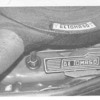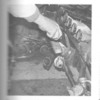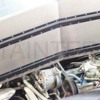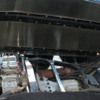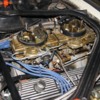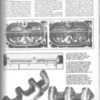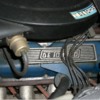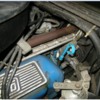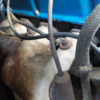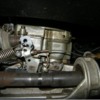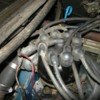Replies sorted oldest to newest
What is the item marked 1003 next to the voltage regulator? Are there any numbers on the voltage regulator?
PM sent
quote:What is the item marked 1003 next to the voltage regulator?
That is the ignition coil.
John
Nonoriginal spark plug wires?
Is that an Autolite 4300? Is it facing the correct way -my (presubably incorrect autolite 4100) carb has throttle linkage facing the other side of the car?
Is that a light next to the voltage regulator- it looks like the one in my front trunk
I am somewhat surprised at the carb alignment (my car's autolite is long gone) but the fuel feed should be in front. Will have to pull vintage magazine pics.
Johnny
quote:Originally posted by LeeA:
another angle...
The carb is backwards. On that carb the choke is on the passenger side.
I looked thru all my old mags, none have the air cleaner off for pics.
quote:Originally posted by Denis C:
Doug, The main concern would be more the fuel line runs on the intake and may cause vapor lock and the pedal cable is crossing over. I wouldn't think DeT would pull the carbs and flip them.
I looked thru all my old mags, none have the air cleaner off for pics.
Really? Well guess what, the throttle lever on the carb on the Mustang is on the drivers side. The throttle rod pulls it back towards the driver.
The choke plate is on the primaries, which are in the FRONT of the carb. That carb is backwards.
I just learned something here about the Mangusta, provided that is an original setup. The carb is mounted reversed. Probably for the throttle cable linkage?
Look at the throttle return spring bracket on the valve cover. That's not stock Ford.
Does anyone have vintage pictures that show that bracket location on the valve cover also, even if the carb can't be seen in the picture? That would tend to indicate that these are original set up, no?
Very interesting set up.
Now having said all of that, the quantity of "original" US Mangusta engine pictures I've seen counting these two...is two.
NOW I'M INTERESTED in seeing more "original" pics too!
I've been combing the net for pictures too and apparently they are as scarce as hens teeth.
There are a couple with the air cleaners on but that doesn't settle much?
I can almost believe that this "backwards" carb is the original setup. I purchased a 1969 4300 carb to put into my car, and I was disappointed to find out that it would not fit in the standard way as the shaft bracket is in the way. There is no way to mount it in the traditional way without moving or removing the shaft and shaft bracket. I didn't think of putting the carb in backwards, but it would probably fit that way in a Mangusta. IF the autolite 4300 is the correct Mangusta carb, I think this is possible.
quote:Originally posted by vyprgt2:
combing the provamo website, I found two other Mangustas (with vins about 30 and 60 higher than Lee's car), that also has throttle linkage on the passenger side of the car. One has the exact same spring bracket on the valve cover!
By the way, does anyone know of any vendor that sells Mangusta tire pressure stickers for the drivers side door?
Can you post those pictures here or at least post a link to them? I'd like to see those also.
To answer DenisC, yes, I can believe Detomaso did this, i.e., mounting the carb backwards. It is a simple solution to what would otherwise be a complex problem.
vvv here is a scan from Petersens "Complete Ford Book" dated 1972.
It is from an article about modifying the engine in a Mangusta. There are no details given about the car itself such as the serial number, owners name, or model year.
This is the passenger side valve cover. I don't see the extra tab on it for the throttle return spring that is shown in the above picture, for the reversed carb.
Attachments
That exhaust manifold looks like a "log type header" to me, like that shown for the Longchamp.
I have seen pictures where the stock Ford 302 cast iron log exhaust manifold is shown on the 'goose..
Found the discussion of 'goose headers here. http://pantera.infopop.cc/eve/...50045562/m/624103536
I think that what is happening is that there are going to be variations on the Mangustas as far as these kinds of details.
Good luck on trying to document anything as "factory original" on these cars.
Attachments
I tried last night to post photos from the provamo website, not sure it is possible, but will try again.
Can you tell from the photo in the book that was scanned if the spark plug wires say autolite and "radio resistance" as per correct Ford wiring of the time?
quote:Originally posted by vyprgt2:
Interesting vintage photos- I had not seen those.
I tried last night to post photos from the provamo website, not sure it is possible, but will try again.
Can you tell from the photo in the book that was scanned if the spark plug wires say autolite and "radio resistance" as per correct Ford wiring of the time?
No. It is a wonder that the scan came out this clear as it is.
You can see that there is white printing on the wires, but when I enlarge it, there isn't enough resolution in the scan to read it at all.
I can say that question came up the other day in relation to original Shelby GT350's and the answer is that radio surpression wire sets were not installed on the engines at the Cleveland assembly plant.
They were available as service sets through the Ford parts program.
If I extrapolate that to the Detomaso's then I would think that the 302 was purchased as a "crate engine" and as such it was the exact engine that was being installed into Ford domestic 1968 model year vehicles.
If that is so, then the answer is no. Radio suppression wires should not be standard equipment on these engines.
I wonder why you are concerned with that detail though.
There is no judged concourse for these cars that I know of in the US. Even if there was, it would be very difficult to find someone qualified enough to judge the car for originality.
You are probably correct about gt350 , but 68-70 289s and 302s came with autolite radio resistance spark plug wires. Why am I concerned- well, I have totally incorrect accel gray wires on my car, and it deserves better. For my own satisfaction, I would like to return the car to reasonably "correct" condition where possible.
Can't drag photos from the website: http://www.provamo.com/login.asp. From another website, here is 1032 http://www.mangustainternation...1032/8ma1032-004.jpg and 982 http://www.mangustainternation...ma982/8ma982-003.jpg
Looking at all the cars, 1046, 1048, 1108 and 1126 all clearly show the spring mount for throttle on passenger side valve cover. Vast majority of cars do not have original valve covers anymore. Throttle links clearly on passenger side of 1078 and 1032. 982 has what appears to be "backwards" 4300 but couldn't really tell much else. I am becoming convinced that Lee's car's carb is correct, even though it seemed to surprise us.
Maybe for the later cars, once the 4300 appeared, DeTomaso just switched the orientation of the carb? My theory is the scan above is of an early car with a carb that can be mounted in the traditional direction (a 4100 carb presumably)
That right there is a difference in the carburetors, 4100 vs. 4300.
If you want wires that look more correct, then you want black AUTOLITE labeled wires, not Motorcraft.
Not so sure about the radio suppression wires on the 68 Mustangs and Shelbys. I personally am using the blue 8mm silicone Ford labeled wires on both my Pantera and my 68 GT350.
I always like to throw whatever I know into a discussion. My philosophy is that even if I am wrong and the part is "incorrect", it stirs up a discussion and gets others involved who would never be involved normally. All benefit from the revealed information and the "corrections".
I'd like to see some input on the exhaust manifolds on the Mangusta's also. I'm not entirely convinced that the iron manifolds all clear the chassis.
The 289hp in particular is a type of a cast header. It does hug the block but even so in the Mustang it requires it's own clutch z-bar to clear it.
Not having a 'goose, but always on the lookout for the one that is destined for me, the picture I posted of the exhaust manifold lends me to believe there are special considerations in this chassis?
I would expect that there are tube headers made for the car at sometime? Those I would like to see.
I discovered purely by accident that the 69 351w cast iron exhaust manifolds are like a larger version of the 289hp iron manifolds. They use a 2-1/4" OD exhaust pipe vs. a 2" on the 289 and adapt well to a 2-1/2" od exhaust pipe.
I have a set here that were "ported", or port matched to a Mr.Gasket exhaust gasket and definitely improve the flow of the exhaust system.
Attachments
Neither are stock set ups. On the top one, the Holley is definitely mounted backwards and the return spring is running to the passenger valve cover.
Attachments
The reason I post this is because it is the same basic engine as in the 'goose, a '68 302 4v.
It uses the Ford 427 2x4 linkage which mounts the carbs backwards.
The intake manifold is the Blue Thunder reproduction "high-rise" manifold which is port matched to the heads.
Personally, this would be on the agenda for me in a "goose".
It is relatively trouble free, and goes like stink.
My Pantera makes about 100 hp more, but that is an unfair comparison because of the different heads.
I wouldn't exactly call it a sleeper but it is undercover enough for me. With the look of the 302 SB, no one suspects it is 5.6 litres. It aslo "hides" a NOS cheater nitrous oxide system as well.
I wouldn't mess with Webers on a 'goose. This set up here produces noticibly more low end because of the progressive throttle design.
Probably some finagaling would need to be done because of the "jack" shaft mounting in the 'goose, but I can testify this set up "runs" and is very civil on the street.
Attachments
Maybe you can determine what year the car is from the rear shot? I can't.
Skinny tires?
Attachments
The picture of the carb venturis of the 4300 is showing the difference between the stock 450cfm and the 600cfm version and suggesting a swap to it.
A 289hp would have a different carb stock. A 4100.
Attachments
There may have been 4-5 Mangusta built with 289HiPo's, but as a Mustang/Shelby guy I/we/you should know there were no 289s available after June 68, so the Euro/US thing is crap. I have a late car 8MA1244 and it has a 302 and unless you get down and dirty under the starter to see castings, see the front crank pulley or pull the heads one can't see the difference. 4 ways to ID a euro car; Km speedo, no rear markers (car in article is US car), and 2 tone tailights (which some owners now have changed)and some cars have a park lamp in the outer front HL ( but that is hard to see unless you turn on park lamps or see the flat beam.
As far as I understand my car (I have quite easily pulled the trans to change clutch BTW) there is no way the cast iron manifold would ever fit in there. When I purchased my car it had a 750Holley4160 with mech secondaries with the linkage on driver's side, it went like stink was real thirsty. left a trail of fumes and kept-up with cats, but I thought it was way too much carb, went to a 625 Holley 4150 vaccum secondaried with choke and lost a bit of bottom end but everything bolts fine, still plenty of fun to drive and a litle less thirsty, (a stock early Cat is still a few points better on gas on the highway though - ask Charlton
my 2c but we are waaay off subject here.
quote:Originally posted by Denis C:
my 2c but we are waaay off subject here.
Thanks for the heads up! I'll keep a lookout for the Mangusta Secret Police!
FYI, there were 289's including the HP available through the Ford Parts system into the early '70s. Stating that there were only 4 or 5 289hp cars would seem that is speculation on your part.
...AND the thread is about original ENGINE COMPARTMENT PHOTOS...are you reading this Secret Police
Show me the documentation.
...and NOT TO BE ARGUMENTATIVE Dennis, but you have just stated that you didn't get your car in the original configuration. It had already been modified.
...AND the original subject of the post is about pictures of the original engine compartment. Are you reading this MSP? (< Mangusta Secret Police)
FWIW: I have spent a few hour doing the research and will stand by my findings.
John: the repro Autolite plug wires look right but are not very good, most early mustang restorers use Taylor brand wires, they need to be custom fitted but look right and last a long time.
If your theory is correct then I would think that there would be later 302's in the later cars?
There are 69, 70 and 71 models of the 'goose.
No matter. No pissing contest for me. I just dribble now.
How well are the Mangustas documented by Detomaso? Manufacturing dates would have been kept, no?
I would think that might effect this carb reversal situation too?
J codes have their date codes stamped into the block near the water pump and the engine tag has the engine date on it as well.
You could document that information with enough owners reporting to a central registrar I would think?
Detomaso could have bought a batch of J codes and just stored them until gone. That could account for all J codes into the '70 models too?
so, wouldn't almost all Mangustas, except the first ones, have 4300s? If Denis's theory about DeT and 289s is right, then all but a handful of cars at most would have 4300s.
Wild speculation here, but maybe DeTomaso designed the Mangusta with 289 and 4100 in mind and when 4300 came along it wouldn't fit due to jack shaft and so he put them in "backwards"?.
1046, 1108 and 1126 provide somewhat compelling evidence as they are overall mostly original cars -
Doug, thanks for posting these scans. They are great
quote:Originally posted by vyprgt2:
As I recall, the 4100 was phased out in 1967 and superseded by the 4300. Other than 289 hipo in 1967, the only later cars that received 4100's were police cars- I think, anyway.
so, wouldn't almost all Mangustas, except the first ones, have 4300s? If Denis's theory about DeT and 289s is right, then all but a handful of cars at most would have 4300s.
Wild speculation here, but maybe DeTomaso designed the Mangusta with 289 and 4100 in mind and when 4300 came along it wouldn't fit due to jack shaft and so he put them in "backwards"?.
1046, 1108 and 1126 provide somewhat compelling evidence as they are overall mostly original cars -
Doug, thanks for posting these scans. They are great
I think that is reasonable speculation, yes.
Since almost all of the Mangustas apparently were for the US market, I would think DT didn't want to touch the engines. They were already designed to comply with the then current EPA and California emissions regulations.
Reversing the carbs seems the simplest solution to clearing the existing jack shaft. Speculation on my part of course.
I enjoyed looking at that article again. Hadn't seen it since the mid '70s.
I'm glad it was helpful to you.
I like these cars too and these discussions I think are helpful in finding accurate information. I have never seen anyone attempt to document Mangusta details before?
That's why I participate in them. Not to bust 'em on DennisC.
I did find this though http://www.mangustainternational.com/
More pics of the car.. But at least, here are pics of the passenger side. The vacuum motor is a Ford part, note the paint on the sides.
Goose parts book shows that there was a 2nd "302" air cleaner, from what I can tell the vacuum motor was added when the smogged J-code was phased in.
Attachments
Guys, the pictures above are from 8ma1046. I believe the carb orientation is correct, at least for that car ![]()
The clue is the choke riser, see also the header pics that Steve L posted today, showing a clear attachment on the left header for the choke riser.
(ps, picture of choke riser on 8ma1074)
Attachments
Pic of 1046 on the linkage side. Detail of throttle cable bracket. carb is #C8ZF-C (used on 4-speed 302). fuel lines were 2 runs of copper, first wrapped around the fuel pump and was spliced to the one clamped to the intake manifold on the driver's side. pictures from 2 cars here (ignore the steel line).
Attachments
I just like this view...note the clutch hose (and of course the AC compressor) are not original. But note the texture on the frame, the aluminum color of the mufflers, and the red inspection marks on the bolts and end of the ZF. Fun stuff. Whoever owns 1046 now is a lucky guy...Lee
Attachments
It was said that because what the air injectors actually did was continue the combustion into the exhaust manifolds, the steel tube headers would burn out.
Granted there doesn't seem to be many if any high mileage Mangustas that we can look at to check out the condition of the headers, but seeing these couple of sets here, there doesn't seem to be any indication that the headers were getting burned through?
Interesting.


